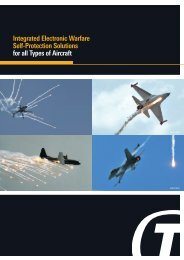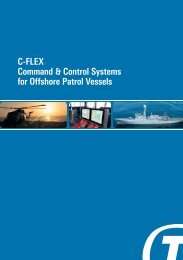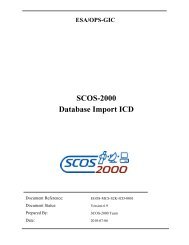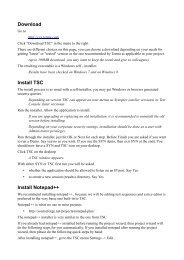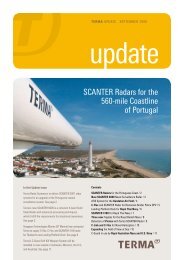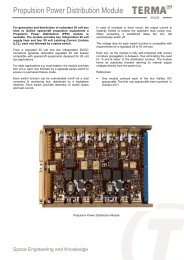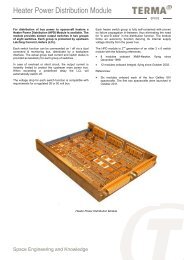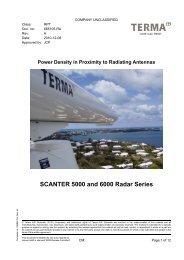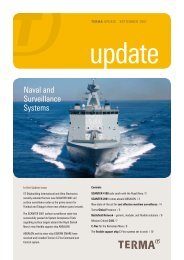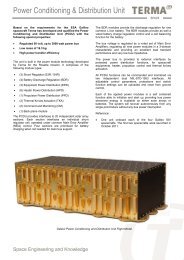Detection and Tracking of Aircraft over Wind Farms using ... - terma
Detection and Tracking of Aircraft over Wind Farms using ... - terma
Detection and Tracking of Aircraft over Wind Farms using ... - terma
You also want an ePaper? Increase the reach of your titles
YUMPU automatically turns print PDFs into web optimized ePapers that Google loves.
<strong>Detection</strong> <strong>and</strong> <strong>Tracking</strong> <strong>of</strong> <strong>Aircraft</strong> <strong>over</strong> <strong>Wind</strong> <strong>Farms</strong> <strong>using</strong><br />
SCANTER 4002 with Embedded Tracker 2<br />
K. Hansen, A.C.K. Thomsen, M.A. Riis, O. Marqversen, M.Ø. Pedersen, E. Nielsen<br />
Terma A/S, Hovmarken 4, 8520 Lystrup, Denmark<br />
Contact email: kha@<strong>terma</strong>.com<br />
Keywords: Air traffic control, radar, tracking, wind<br />
farms.<br />
Abstract<br />
Test results <strong>of</strong> aircraft detection <strong>and</strong> tracking <strong>over</strong> large<br />
<strong>of</strong>fshore wind farms show that a track can be maintained on a<br />
light manoeuvring aircraft as well as general aviation aircraft<br />
<strong>using</strong> an <strong>of</strong>f-the-shelf radar solution. The optimum strategy <strong>of</strong><br />
mitigating the deteriorating effects <strong>of</strong> closely spaced wind<br />
turbines on air surveillance is shown to depend on the<br />
characteristics <strong>of</strong> the wind farm, in particular the density <strong>of</strong><br />
the wind turbines.<br />
1 Introduction<br />
The emerging issues for maintaining c<strong>over</strong>age <strong>of</strong> air targets<br />
close to <strong>and</strong> above wind farms can be addressed from<br />
different viewpoints. Most papers address the possible<br />
problems regarding air c<strong>over</strong>age at wind farms. This paper<br />
describes the obtained test results <strong>using</strong> an '<strong>of</strong>f the shelf<br />
solution' at two different test sites. The radar transceiver <strong>and</strong><br />
tracker used on both test sites will first be presented. This is<br />
followed by a description <strong>of</strong> a test involving a controlled,<br />
small, fixed wing aircraft manoeuvring <strong>over</strong> the two <strong>of</strong>fshore<br />
wind farms Horns Rev I <strong>and</strong> II. We proceed by discussing<br />
various options with regard to the radar video used as input to<br />
the tracker. Results from the Horns Rev tests are then<br />
presented. Another test site at Copenhagen Airport is<br />
described, where the setup is used as a Terminal Approach<br />
Radar demonstrating also tracking <strong>of</strong> air targets passing <strong>over</strong><br />
Lillgrund, a nearby <strong>of</strong>fshore wind farm. Here tracking is done<br />
on radar video where individual wind turbines have been<br />
blanked out. We present results on how the blanking affects<br />
the target plot probability <strong>of</strong> detection, track loss probabilities<br />
accumulated from more than 200 air targets <strong>of</strong> opportunity<br />
passing <strong>over</strong> the wind farm <strong>over</strong> a period <strong>of</strong> six days.<br />
The requirements for inter-turbine detectability <strong>and</strong> the<br />
obtained specification <strong>of</strong> SCANTER 4002 are discussed in<br />
detail in [6]. The requirements for inter-turbine detectability<br />
relate to:<br />
• Azimuth antenna resolution<br />
• Range resolution<br />
• CFAR processing<br />
• Instantaneous linear dynamic range<br />
• Adaptive sensitivity control<br />
• Pulse compression range side lobes<br />
• Azimuth antenna side lobes<br />
• MTI/MTD suppression <strong>of</strong> clutter between turbines<br />
To summarize, the stated requirements in [6] are met very<br />
well by SCANTER 4002.<br />
2 Radar configuration<br />
The radar set-up includes a SCANTER 4002 <strong>and</strong> a 15’ Large<br />
Aperture Antenna System [7], both produced by Terma in<br />
Denmark. The antenna has a csc 2 elevation pattern, circular<br />
polarization, a gain <strong>of</strong> 39 dB i , <strong>and</strong> a 3 dB azimuth beam width<br />
<strong>of</strong> 0.57°. SCANTER 4002 is the latest version <strong>of</strong> the <strong>of</strong>f-theshelf<br />
product series <strong>of</strong> SCANTER 4000, now operating<br />
worldwide. The SCANTER 4002 radar sensor is an X-b<strong>and</strong>,<br />
2D, fully coherent pulse compression radar providing both<br />
enhanced Moving Target Indication (MTI) <strong>and</strong> Normal radar<br />
(Non-MTI) video simultaneously. This enables a high level <strong>of</strong><br />
situational awareness <strong>and</strong> support multiple concurrent<br />
operational needs e.g. air surveillance, helicopter control,<br />
surface surveillance <strong>and</strong> Search <strong>and</strong> Rescue. No secondary<br />
surveillance radars (SSR) were used during the tests.<br />
The SCANTER 4002 generates both network video <strong>and</strong><br />
plot/tracks to be <strong>over</strong>layed on the video. Two types <strong>of</strong> video<br />
output are generated in parallel: Processed air targets video<br />
<strong>and</strong> Processed surface target video. Both video channels are<br />
based on combined MTI <strong>and</strong> Normal radar video, but the<br />
post-processing is configured differently, optimized for<br />
detection <strong>of</strong> the different target types. As a consequence, the<br />
processed air targets video can also include small distinctive<br />
targets that usually are present in the normal radar video only.<br />
A full resolution attenuation map can be included in the<br />
processing. The map blanks each video cell individually if<br />
applied <strong>and</strong> can be set to include stationary targets as wind<br />
turbines.<br />
The network radar video is processed by the Embedded<br />
Tracker 2 (ET2), see Fig. 1. The ET2 is a knowledge-based<br />
[3], auto-adaptive, probabilistic radar tracker, which<br />
integrates with most <strong>of</strong> the SCANTER family <strong>of</strong> radar<br />
sensors. The ET2 is developed by Terma <strong>and</strong> has been<br />
available on the market since June 2012.<br />
C4.2 Proceedings Radar 2012, Glasgow, UK, © IET 1
In the ET2, network radar video is first passed through a plot<br />
extractor, which identifies areas <strong>of</strong> connected radar cells <strong>over</strong><br />
a given video threshold. The plot extractor calculates a set <strong>of</strong><br />
properties for each plot: The plot centre <strong>and</strong> plot centre<br />
positional covariance in slant range <strong>and</strong> bearing, the<br />
observation time, the maximum intensity <strong>of</strong> the video level <strong>of</strong><br />
radar cells in the plot as well as other features related to the<br />
plot shape <strong>and</strong> size. Plots may be due to targets, clutter or<br />
noise.<br />
position, velocity <strong>and</strong> turn rate in the horizontal plane. The<br />
maximum video level in a plot is used by the feature<br />
estimator to find the plot intensity probability conditioned the<br />
maximum video level found in the most recent plot associated<br />
with a target. The probability <strong>of</strong> detection estimate is used by<br />
the track pool component to terminate a track if it drops<br />
below a configurable threshold. The memory <strong>of</strong> the<br />
probability <strong>of</strong> detection estimator is configured in terms <strong>of</strong> a<br />
decay time <strong>and</strong> distance, which takes into account the<br />
temporal <strong>and</strong> spatial variance in the detection probability <strong>of</strong> a<br />
target.<br />
On reception <strong>of</strong> each plot, the data associator identifies<br />
possible plot-track associations. The optimal plot-track<br />
association pairs are found <strong>using</strong> likelihood based 2Dassignment<br />
including both a kinematic <strong>and</strong> a feature term [2].<br />
The assigned tracks update their estimators with the new plot<br />
<strong>and</strong> the track pool promotes or terminates tracks <strong>and</strong> sends the<br />
results to the track publisher. Unused plots are added to the<br />
pool <strong>of</strong> tentative tracks [3] <strong>and</strong> used in the next scan as track<br />
c<strong>and</strong>idates.<br />
Finally, the plot publisher has the responsibility to publish<br />
tracks to one or more tracker clients on a network connection.<br />
The published tracks form a subset <strong>of</strong> the confirmed tracks<br />
from the core tracker, which fulfil certain publication criteria.<br />
For instance, the track publisher may suppress the publication<br />
<strong>of</strong> tracks, which has never moved above a certain speed <strong>over</strong><br />
ground with statistical significance, to suppress static or slow<br />
targets (wind turbines, masts, ships, birds, etc.).<br />
Figure 1: System diagram <strong>of</strong> the ET2<br />
Extracted plots are sent to a plot publisher <strong>and</strong> a clutter<br />
density estimator. The plot publisher publishes plots to the<br />
outside world via a network port. The clutter density<br />
estimator uses incoming plots to estimate the density <strong>of</strong> plots<br />
in range, bearing <strong>and</strong> intensity <strong>and</strong> augments this density as<br />
an attribute to each plot, which are then sent to the core<br />
tracker application (blue boxes in Fig. 1) ordered by<br />
observation time.<br />
The ET2 can maintain 1000 confirmed tracks while running<br />
on a modest hardware platform (a dual core 1.6 GHz PC<br />
platform). It automatically adapts its capacity to the available<br />
hardware resources.<br />
3 Horns Rev Tests<br />
The core tracker consists <strong>of</strong> three interacting components; a<br />
data associator, an estimator <strong>and</strong> a track pool. The data<br />
associator assigns incoming plots with tracks predicted to the<br />
observation time <strong>using</strong> the estimator. On assignment, the<br />
estimator updates the target state vector with the assigned<br />
plot. A track pool maintains the state <strong>of</strong> each track (tentative,<br />
confirmed, terminated).<br />
The estimator component is composed <strong>of</strong> three independent<br />
estimators: An Interacting Multiple Models (IMM) estimator<br />
[1] for the target kinematics, a knowledge-based [3] estimator<br />
for target features, <strong>and</strong> a sequential Bayesian probability <strong>of</strong><br />
detection estimator [4]. The IMM maintains an estimate <strong>of</strong> a<br />
target state vector <strong>and</strong> covariance matrix containing the target<br />
Figure 2: Overview <strong>of</strong> the Horn Rev/Blåv<strong>and</strong>shuk test site.<br />
To test the ability <strong>of</strong> the described system to detect <strong>and</strong> track<br />
aircraft in the vicinity <strong>of</strong> large wind farms, a test was<br />
conducted at a test site located at 55°33.229’N 8°5.5446’E<br />
near Blåv<strong>and</strong>shuk on the West coast <strong>of</strong> Jutl<strong>and</strong>, Denmark, see<br />
Fig. 2. At the test site, the antenna system was installed at a<br />
C4.2 Proceedings Radar 2012, Glasgow, UK, © IET 2
height <strong>of</strong> 12 m ASL with direct visibility to the <strong>of</strong>f-shore<br />
wind farms Horns Rev I (80 wind turbines, 70 m hub height,<br />
80 m rotor diameter, 3-4 turbines/km 2 ) <strong>and</strong> Horns Rev II (91<br />
wind turbines, 68 m hub height, 93m rotor diameter, 3-4<br />
turbines/km 2 ). To enable later <strong>of</strong>fline analysis, data were<br />
recorded at three different points in the signal processing:<br />
Unprocessed transceiver data, radar video, <strong>and</strong> screen dumps<br />
from the PPI used. The ET2 was not available at the time <strong>of</strong><br />
the tests, <strong>and</strong> the tracking results presented in this paper have<br />
been obtained by replaying some <strong>of</strong> those data after the actual<br />
test. The radar antenna was operated at 15 RPM during the<br />
tests.<br />
The primary controlled test target was a light aircraft, a<br />
Grumman GA-7 with a wingspan <strong>of</strong> 11.23 m. This aircraft<br />
has been used at several factory acceptance tests <strong>of</strong><br />
SCANTER 4000 products where its radar cross section has<br />
been measured to be between 1 <strong>and</strong> 4 m 2 depending <strong>of</strong> the<br />
aspect angle.<br />
The controlled aircraft was comm<strong>and</strong>ed to pass the two wind<br />
farms in a variety <strong>of</strong> different directions, heights, speeds, <strong>and</strong><br />
weather conditions. The test was scheduled to take place <strong>over</strong><br />
a number <strong>of</strong> days to have different weather conditions. The<br />
results presented here are from the first test day, March 29,<br />
2011, with wind from west 5-10 m/s, no precipitation, <strong>and</strong><br />
the GA-7 flying at an altitude <strong>of</strong> 5000 ft.<br />
The wind turbines are excluded from the CFAR processing by<br />
individual masking. This is required to avoid desensitization<br />
in the vicinity <strong>of</strong> the wind turbines. The result <strong>of</strong> a successful<br />
masking is shown in Figure 3, where a special option on the<br />
radar has been enabled, allowing the receiver noise floor to be<br />
seen. The noise floor is flat between the turbines <strong>and</strong> at the<br />
same level as outside the wind farm, showing that the CFAR<br />
processing does not introduce desensitization in the area <strong>of</strong><br />
the wind farm. The high azimuth resolution <strong>of</strong>fered by X-<br />
B<strong>and</strong> combined with the 60 dB Peak Side-Lobe Ratio <strong>of</strong><br />
SCANTER 4002 facilitates the ability to resolve air targets<br />
from individual wind turbines.<br />
order to avoid a lot <strong>of</strong> plots from the static wind turbines in<br />
the tracker. On the other h<strong>and</strong>, by allowing the wind turbine<br />
video to be extracted as plots <strong>and</strong> be used in the tracker, they<br />
can be identified as static targets. Once established as static<br />
targets, they will have high association likelihood to new<br />
plots <strong>over</strong>lapping the track updated position, <strong>and</strong> thereby help<br />
consume wind turbine plots <strong>and</strong> lower the risk <strong>of</strong> track<br />
seductions. This reduces the possible plot-track associations<br />
for an air target passing <strong>over</strong> the wind farm. For the Horns<br />
Rev tests with the ET2, we have found that letting the wind<br />
turbine video through results in better tracking performance.<br />
This is due to the fact that almost every turbine is resolved in<br />
the radar video <strong>and</strong> there is still significant room in between<br />
turbines for target plots. That is, there is a small probability <strong>of</strong><br />
coalescence between a target plot <strong>and</strong> a wind turbine plot.<br />
Since the ET2 can maintain more than 1000 concurrent<br />
internal tracks, the additional processor load from maintaining<br />
track on less than 200 static wind turbines besides moving<br />
targets is not a limiting factor.<br />
In Fig. 4 is shown the 4 min track history trail (grey dots, one<br />
per scan) for the GA-7 performing a coordinated turn at a rate<br />
<strong>of</strong> approximately 3°/sec after passing <strong>over</strong> Horns Rev 2. The<br />
last updated position <strong>of</strong> all confirmed tracks is marked with a<br />
white circle. It is observed that the updated track position <strong>and</strong><br />
speed vector for the GA-7 follows the turn closely with no<br />
apparent <strong>over</strong>shoot. This is due to the presence <strong>of</strong> a nearly<br />
coordinated turn model in the IMM [1]. It is seen that most<br />
wind turbines are tracked as static targets (no velocity vector<br />
seen). For some turbines their plots coalesce when aligned in<br />
cross-range due to the azimuth beam width <strong>of</strong> the radar<br />
antenna.<br />
Figure 3: Non-thresholded radar video <strong>over</strong> a section <strong>of</strong><br />
Horns Rev 2.<br />
3 Video Considerations<br />
In the radar there is a possibility to mask out the wind<br />
turbines in the produced video. This feature can be enabled in<br />
Figure 4: ET2 track <strong>of</strong> GA-7 with static targets shown.<br />
In aircraft surveillance applications, the static wind turbine<br />
targets are <strong>of</strong> little interest in the control systems f<strong>using</strong> track<br />
data from different sensor systems. To clean up the published<br />
tracks a target speed filter is applied in the track publisher,<br />
C4.2 Proceedings Radar 2012, Glasgow, UK, © IET 3
which only allows the publishing <strong>of</strong> tracks, which has had an<br />
estimated speed <strong>over</strong> ground exceeding 25 m/s in five<br />
consecutive scans.<br />
lacks on the aircraft track. In this case, it experiences two<br />
such consecutive lacks right when the targets begins its<br />
manoeuvre, see red circles in Fig. 6. This is followed by a<br />
successful update with an inter-turbine target plot (green<br />
circle), which corrects the course <strong>and</strong> allows the track to be<br />
maintained in the scans to follow.<br />
Figure 5: ET2 track <strong>of</strong> GA-7 manoeuvring <strong>over</strong> Horns Rev 2.<br />
Static targets not published.<br />
In Fig. 5 is shown how the publication filter completely<br />
removes all static tracks. It is crucial to underst<strong>and</strong> that the<br />
static targets are still being tracked internally in the tracker,<br />
they are just not published.<br />
5 Horns Rev Test Results<br />
Figure 6: Zoom on the tracks updates during a 40° turn. Two<br />
coasting updates marked with red circles are followed by an a<br />
update with a target plot marked by a green circle.This is<br />
demonstrated in Fig. 7 where the track is maintained on the<br />
GA-7 as it flies towards Horn Rev 1, makes a 55° turn <strong>and</strong><br />
passes <strong>over</strong> it. The complete tracking sequence is available<br />
online [5].<br />
In Fig. 5, the target again moves <strong>over</strong> Horns Rev 2 following<br />
the turn in Fig. 4. Only this time, the aircraft makes a 40° turn<br />
while passing the wind farm, changing its course <strong>over</strong> ground<br />
from 100° to 140°. It is a challenge to maintain a track on the<br />
target under these conditions. Approximately one third <strong>of</strong> the<br />
target plots coalesce with the wind turbine plots, which<br />
associate with the static wind turbine tracks. This leads to<br />
Figure 7: ET2 track trail <strong>of</strong> GA-7 continuing its flight from<br />
Horns Rev 2 to Horn Rev 1.<br />
6 Copenhagen Airport Tests<br />
To test the ability to track a wide variety <strong>of</strong> aircraft <strong>over</strong> wind<br />
farms <strong>and</strong> also the ability for the SCANTER 4002 to operate<br />
as a Terminal Approach Radar (TAR), a test site was setup in<br />
Copenhagen Airport at the position 55°37.114’N<br />
12°38.051’E , next to Tower 1 in May 2012. The Horn Rev<br />
radar transceiver <strong>and</strong> antenna system was used, only this time,<br />
the radar antenna was installed on top <strong>of</strong> a 24 m mast, giving<br />
an antenna height <strong>of</strong> approximately 30 m ASL, which is the<br />
same height as the primary radar in the airport. Copenhagen<br />
Airport is the busiest airport in Sc<strong>and</strong>inavia, with dense air<br />
traffic. More<strong>over</strong>, it is located close to several large <strong>of</strong>fshore<br />
wind farms, <strong>of</strong> which the largest is Lillgrund <strong>Wind</strong> Farm, (48<br />
wind turbines, 65 m hub height, 93 m rotor diameter, 10<br />
turbines/km 2 ) located 15 km to the SE <strong>of</strong> the test location.<br />
Due to size constraints in this region, the wind farm layout is<br />
dense, with an inter-turbine distance <strong>of</strong> 300-350 m. The<br />
density <strong>of</strong> wind turbines in Lillgrund is thus approximately 3-<br />
4 times larger than for Horn Rev I <strong>and</strong> II.<br />
The non-thresholded video <strong>over</strong> Lillgrund is shown to the left<br />
in Fig. 8. The noise threshold is still constant in between the<br />
turbines indicating that there is no loss <strong>of</strong> sensitivity.<br />
However, for the Lillgrund case it turns out to be hard to<br />
maintain an internal static track for each wind turbine. From<br />
scan to scan, they <strong>of</strong>ten coalesce with neighbouring turbine<br />
plots. More<strong>over</strong>, the large density <strong>of</strong> plots is detected as a<br />
very large clutter density in the area by the clutter density<br />
estimator in the ET2. This makes track initialization <strong>and</strong><br />
maintenance on the static wind turbines slow <strong>and</strong> a track<br />
C4.2 Proceedings Radar 2012, Glasgow, UK, © IET 4
cannot reliably be maintained on each turbine. This leads to<br />
track seduction for aircraft passing <strong>over</strong> the wind farm, as an<br />
air track may associate with a wind turbine plot instead <strong>of</strong> an<br />
air target plot, especially if the air target manoeuvres.<br />
lacks on its way towards the wind farm <strong>and</strong> is then lost. This<br />
could be a false track.<br />
Tracks can be maintained quite easily <strong>over</strong> the wind farm<br />
albeit the probability <strong>of</strong> detection goes down, because most<br />
commercial aircraft passing <strong>over</strong>, only manoeuvres very<br />
slightly. From track data accumulated <strong>over</strong> six days from June<br />
30 to July 5, 2012 it was found that 218 air tracks had one or<br />
more track reports (updating or coasting) <strong>over</strong> the wind farm.<br />
Of these, 17 tracks (8%) were lost . For inbound tracks, the<br />
probability <strong>of</strong> plot detection is 96% in a sector with a bearing<br />
130°-150° <strong>and</strong> range 10-20 km. Inside the wind farm it drops<br />
to 58% due to the masked out turbines.<br />
Figure 8: Non-thresholded radar video <strong>of</strong> Lillgrund wind farm<br />
without (left) <strong>and</strong> with (right) individual wind turbines<br />
masked out. To the right is also seen a track maintained on an<br />
air target passing <strong>over</strong> the wind farm.<br />
For the Copenhagen Airport tests we have therefore chosen to<br />
mask out the wind turbines in the video, see Fig. 8 (right). If<br />
the masking is done accurately, <strong>over</strong>lapping target plots will<br />
<strong>of</strong>ten spill <strong>over</strong> into the unmasked regions <strong>and</strong> lead to a<br />
clipped plot, which can still be used to associate with a an air<br />
target track. More<strong>over</strong>, the static wind turbine plots do not<br />
add to the estimated clutter density easing track initialization<br />
<strong>and</strong> maintenance in the vicinity <strong>of</strong> the wind farm. An example<br />
is shown in Fig. 8 (right), where an air target passes <strong>over</strong> four<br />
turbines in three scans without a track lack.<br />
A snapshot <strong>of</strong> the track situation picture is shown in Figure 9<br />
<strong>using</strong> the same track publication criteria as for the Horns Rev<br />
Tests. Two air targets with IDs 5708 <strong>and</strong> 6263 are<br />
approaching with speed <strong>over</strong> grounds <strong>of</strong> 177 <strong>and</strong> 96 knots,<br />
respectively demonstrating the capability <strong>of</strong> the system to<br />
work as a TAR. Another track with ID 7014 has just taken <strong>of</strong>f<br />
from the airport <strong>and</strong> is approaching the Eastern edge <strong>of</strong> the<br />
masked out Lillgrund wind farm at a speed <strong>over</strong> ground <strong>of</strong><br />
257 knots. The trail <strong>of</strong> a fourth track passing East <strong>of</strong><br />
Lillgrund is also seen. It should be noted, that since no SSR<br />
radar information was used, the track ID is a unique number<br />
designated to the target by the tracker, <strong>and</strong> not the squawk<br />
code used by the aircraft transponder.<br />
Only a small fraction <strong>of</strong> all aircraft pass <strong>over</strong> the wind farm.<br />
By logging all track data <strong>over</strong> a period <strong>of</strong> days, tracks can be<br />
identified in post-processing which has had one or more track<br />
reports with positions within the wind farm. An example <strong>of</strong><br />
this is seen in Fig. 10 from tracks accumulated <strong>over</strong> six hours.<br />
It is seen that incoming tracks (black) have a probability <strong>of</strong><br />
detection (filled symbols indicate successful plot-track<br />
associations) close to unity. As the tracks pass <strong>over</strong> the wind<br />
farm (blue), the tracks are maintained, but the probability <strong>of</strong><br />
detection drops due to track lacks (hollow symbols). After<br />
having passed the wind farm (green), the probability <strong>of</strong><br />
detection goes up again to near unity. The track trajectories<br />
are smooth, <strong>and</strong> none <strong>of</strong> the tracks are seduced. A single track<br />
Figure 9: ET2 air target track <strong>over</strong>lay on non-thresholded<br />
video from Copenhagen Airport, 13:08:53 (UTC), July 5,<br />
2012. The distance between range rings is 1.5 nmi.<br />
7 Discussion<br />
By including the static wind turbines in the internal tracking<br />
process we can maintain a track on a manoeuvring light<br />
aircraft passing <strong>over</strong> Horns Rev I <strong>and</strong> II wind farms in<br />
different directions. Maintaining internal tracks imposes an<br />
extra load on the tracker, but this is easily accommodated<br />
within the processing capabilities <strong>of</strong> the ET2. Although target<br />
plots occasionally coalesce with wind turbine plots, it is<br />
possible to maintain the track on the target due to the high<br />
resolution <strong>of</strong> the radar sensor without <strong>using</strong> SSR data.<br />
For wind farms with a smaller inter-turbine distance the best<br />
tracking performance is achieved by masking out the wind<br />
turbines in the radar video. Although the masking reduces the<br />
probability <strong>of</strong> detection from 96% to 58%, it is still possible<br />
to maintain track on a large majority (92%) <strong>of</strong> all aircraft<br />
passing <strong>over</strong> the wind farm.<br />
C4.2 Proceedings Radar 2012, Glasgow, UK, © IET 5
Learning Systems for Signal processing,<br />
Communications, <strong>and</strong> Control, Ed. S. Haykin, pp 167-<br />
196, Wiley (New York, 2008).<br />
[4] K.G. Jamieson, M.R. Gupta, D.W. Krout. "Sequential<br />
Bayesian estimation <strong>of</strong> the probability <strong>of</strong> detection for<br />
tracking," Information Fusion, 2009. FUSION '09. 12th<br />
International Conference on, pp 641-648 (2009).<br />
[5] http://www.youtube.com/user/<strong>terma</strong>radar. “SCANTER<br />
4002 with Embedded Tracker 2” (2012).<br />
[6] A. C. K. Thomsen et al. "Air Traffic Control at <strong>Wind</strong><br />
<strong>Farms</strong> with TERMA SCANTER 4000/5000". Radar<br />
Conference (RADAR), 2011 IEEE , pp 247-252 (2011)<br />
[7] A. Østergaard, A. C. K. Thomsen <strong>and</strong> M. Løkke. "A<br />
Lowloss <strong>and</strong> Low Reflection Dual Lens for Shaped<br />
Pattern Applications", Proc. <strong>of</strong> 30th ESA Antenna<br />
Workshop, The Netherl<strong>and</strong>s, pp 303-306 (2008).<br />
Figure 10: Track history for all 21 air tracks passing <strong>over</strong><br />
Lillgrund wind farm during a 12 hour period on June 30,<br />
2012. Filled: update, hollow: lack, black: inbound, blue: <strong>over</strong>,<br />
green: out bounds.<br />
8 Conclusion<br />
The results presented in this paper demonstrates that it is<br />
possible to detect <strong>and</strong> maintain track on a light aircraft<br />
manoeuvring <strong>over</strong> large <strong>of</strong>fshore wind farms <strong>using</strong> a<br />
SCANTER 4002 radar with an ET2 tracker. It is furthermore<br />
shown that commercial aircraft passing <strong>over</strong> a large <strong>of</strong>fshore<br />
wind farm with inter-turbine distances down to 300 m can be<br />
tracked <strong>and</strong> maintained with a probability <strong>of</strong> 92%. For wind<br />
farms with an inter-turbine distance <strong>of</strong> 500 m or larger, the<br />
best results are found by including the turbine video in the<br />
tracking process <strong>and</strong> maintain internal (not published) tracks<br />
on these. For wind farms with a larger density <strong>of</strong> wind<br />
turbines, masking out the wind turbine video can give better<br />
results.<br />
Acknowledgements<br />
The authors would like to thank T. Kirubarajan for fruitful<br />
discussions.<br />
References<br />
[1] Y. Bar-Shalom, X. Rong Li <strong>and</strong> T. Kirubarajan.<br />
"Estimation with Applications to <strong>Tracking</strong> <strong>and</strong><br />
Navigation: Theory, Algorithms <strong>and</strong> S<strong>of</strong>tware", pp 466-<br />
470, Wiley (New York, 2001).<br />
[2] Y. Bar-Shalom, P.K. Willet, X. Tian. "<strong>Tracking</strong> <strong>and</strong><br />
Data Fusion: A H<strong>and</strong>book <strong>of</strong> Algorithms", p. 462, YBS<br />
Publishing (Storrs, 2011).<br />
[3] F. Gini <strong>and</strong> M. Rangaswamy. "Knowledge Based Radar<br />
<strong>Detection</strong>, <strong>Tracking</strong> <strong>and</strong> Classification", Adaptive <strong>and</strong><br />
C4.2 Proceedings Radar 2012, Glasgow, UK, © IET 6


